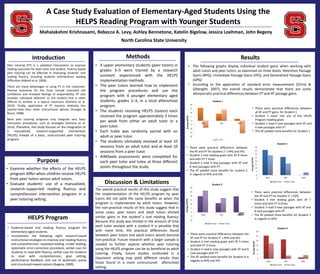
NCSPA_final poster
- 1. A Case Study Evaluation of Elementary-Aged Students Using the HELPS Reading Program with Younger Students North Carolina State University Introduction Mahalakshmi Krishnasami, Rebecca A. Levy, Ashley Bennetone, Katelin Bigelow, Jessica Loehman, John Begeny Purpose Methods HELPS Program Results Peer tutoring (PT) is a validated intervention to improve reading outcomes for both tutor and student. Fluency-based peer tutoring can be effective in improving students’ oral reading fluency, including students with/without reading difficulties (Abbott et al. 2006). There are many advantages to using PT in the classroom. Positive outcomes for the tutor include improved self confidence and renewed feelings of responsibility. PT also provides individual attention to the student that is often difficult to achieve in a typical classroom (Dufrene et al. 2010). Finally, application of PT requires relatively less teacher-time than other instructional options (Kreuger & Braun, 1998). Most peer tutoring programs only integrate very basic instruction procedures, such as strategies (Dufrene et al. 2010). Therefore, this study focuses on the integration of a manualized, research-supported intervention (HELPS) instead of a basic, unstructured peer tutoring program. • Examine whether the effects of the HELPS program differ when children receive HELPS from peer tutors versus adult tutors. • Evaluate students’ use of a manualized, research-supported reading fluency and comprehension intervention program in a peer tutoring setting. • 4 upper elementary students (peer tutors) in grades 3–5 were trained by a research assistant experienced with the HELPS implementation methods. • The peer tutors learned how to implement the program procedures and use the program with 4 younger elementary aged students, grades 1–3, in a local afterschool program. • The students receiving HELPS (tutees) each received the program approximately 3 times per week from either an adult tutor or a peer tutor. • Each tutee was randomly paired with an adult or peer tutor. • The students ultimately received at least 10 sessions from an adult tutor and at least 10 sessions from a peer tutor. • AIMSweb assessments were completed for each peer tutor and tutee at three different points throughout the study. • Evidence-based oral reading fluency program for elementary-aged students. • Incorporates the following eight research-based instructional strategies to improve oral reading fluency and comprehension: repeated reading, model reading, systematic error-correction procedure, verbal cues for students to read with fluency, verbal cues for students to read with comprehension, goal setting, performance feedback, and use of systematic praise and structured reward system (Begeny, 2009). • The following graphs display individual student gains when working with adult tutors and peer tutors, as examined on three levels: Retention Passage Gains (RPG), Immediate Passage Gains (IPG), and Generalized Passage Gains (GPG) • According to the application of standard error measurement (Christ & Silberglitt, 2007), the overall results demonstrate that there are some idiosyncratic practical differences between PT and AT passage gains. • There were practical differences between all AT and PT gains for Student 1 • Student 1 never met any of the HELPS Program reading goals • Student 1 read 4 new passages with AT and 4 new passages with PT • The AT yielded more benefits for Student 1 • There were practical differences between the AT and PT for Student 2’s RPG and IPG • Student 2 met reading goals with AT 8 times and with PT 7 times • Student 2 read 9 new passages with AT and 8 new passages with PT • The AT yielded more benefits for student 2 in regards to RPG and IPG • There were practical differences between the AT and PT for Student 3’s GPG • Student 3 met reading goals with AT 7 times and with PT 6 times • Student 3 read 9 new passages with AT and 8 new passages with PT • The AT yielded more benefits for Student 3 in regards to GPG • There were practical differences between the AT and PT for Student 4’s RPG and IPG • Student 4 met reading goals with AT 5 times and with PT 4 times • Student 4 read 6 new passages with AT and 6 new passages with PT • The AT yielded more benefits for Student 4 in regards to RPG and IPG Discussion & Limitations The overall practical results of this study suggest that the implementation of the HELPS program by peer tutors did not yield the same benefits as when the program is implemented by adult tutors. However, the non-practical results of this study suggest that in some cases, peer tutors and adult tutors elicited similar gains in the student’s oral reading fluency. Because this study was limited in the amount of time each tutor worked with a student it is possible that with more time, the practical differences found between peer tutors and adult tutors would become non-practical. Future research with a larger sample is needed to further explore whether peer tutoring using the HELPS program can be as beneficial as adult tutoring. Finally, future studies conducted in a classroom setting may yield different results than those found in a more unstructured afterschool setting. -20 -15 -10 -5 0 5 10 15 20 RPG IPG GPG AverageWCPM Student 1 AT PT -5 0 5 10 15 20 25 30 35 40 RPG IPG GPG AverageWCPM Student 2 Adult Tutor Peer Tutor -10 -5 0 5 10 15 20 25 30 RPG IPG GPG AverageWCPM Student 3 Adult Tutor Peer Tutor 0 5 10 15 20 25 30 RPG IPG GPG AverageWCPM Student 4 Adult Tutor Peer Tutor